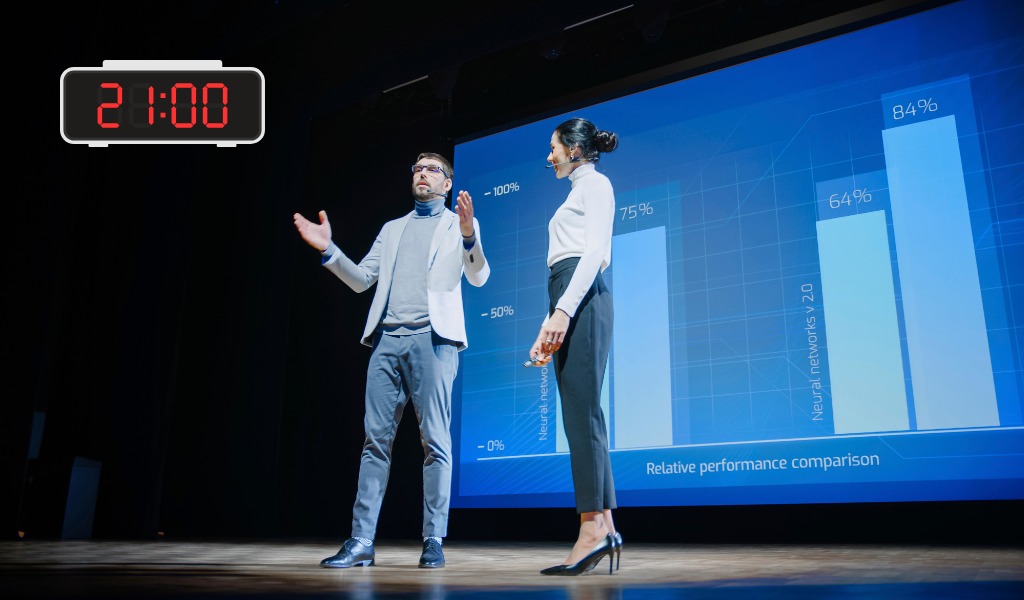How to Keep Speakers on Time with Stage Countdown Timers

One of the biggest challenges in managing conferences and events is ensuring that speakers stick to their allotted time. When presentations overrun, they disrupt the event schedule, shorten Q&A sessions, and frustrate both attendees and organizers.
A structured timing system can prevent such issues. Using a countdown timer for stage ensures that speakers are aware of how much time they have left, helping them stay on schedule without interruptions. Tools like Let’s Time IT provide a discreet yet effective way to manage time efficiently during live events.
Why Time Management is Critical for Speakers
Time management isn’t just about keeping the event on track; it significantly affects audience engagement and the overall experience. Here’s why:
- Keeps Events Running Smoothly – When one speaker overruns, it creates a domino effect that disrupts the entire schedule.
- Enhances Audience Experience – Attendees appreciate a well-structured event with balanced session lengths.
- Maintains Speaker Credibility – A speaker who finishes on time appears well-prepared and respectful of other participants.
- Allows for Proper Q&A Sessions – Keeping track of time ensures that audience members get the chance to ask questions without rushing.
How Stage Countdown Timers Help Speakers Stay on Track
A countdown timer for speakers is an essential tool for event management. Here’s how it helps:
1. Provides a Visual Cue
Having a timer displayed on stage allows speakers to track their time without constantly checking the clock. This reduces distractions and keeps them focused on delivering their content effectively.
2. Enables Discreet Time Notifications
With tools like Let’s Time IT, event organizers can send subtle reminders or adjust timers without interrupting the presentation.
3. Encourages Speakers to Structure Their Content
Knowing there’s a fixed time limit encourages speakers to break down their presentation into well-defined sections, ensuring a smooth and engaging delivery.
4. Helps Prevent Overruns and Last-Minute Rush
A visible timer eliminates the tendency of speakers to go off track, allowing them to conclude on time while covering key points effectively.
Best Practices for Using a Stage Timer Effectively
A. Set Clear Time Limits
Before the event, communicate the allotted time for each session so that speakers can prepare accordingly.
B. Use a Remote-Controlled Timer
A countdown timer for the stage that can be controlled remotely allows organizers to make adjustments without disrupting the event.
C. Display Warnings at Key Intervals
Timers should indicate when a speaker is nearing the end of their session. For example:
- Yellow light at 5 minutes remaining
- Red light at 1 minute remaining
D. Synchronize Timer with Event Agenda
Ensure that the countdown system is aligned with the event schedule to avoid any inconsistencies.
How to Implement a Stage Timer for Your Event
- Choose the Right Timer Tool – Use a professional event timer like Let’s Time IT that integrates seamlessly with stage presentations.
- Position the Timer Strategically – Place the timer where speakers can see it clearly but without distracting the audience.
- Train Speakers on Timer Usage – Brief presenters on how to use the timer and follow its cues.
- Monitor and Adjust as Needed – Use a remote-controlled system to make real-time changes based on event progress.
Conclusion
Keeping speakers on time is crucial for maintaining a well-organized and engaging event. Using a countdown timer for speakers provides a structured approach to time management, ensuring smooth transitions between sessions. With the right tools and best practices, event organizers can create a seamless and professional experience for both speakers and attendees.
By integrating solutions like Let’s Time IT, you can effectively manage time at your next conference or event, ensuring every session stays on track while keeping your audience engaged.